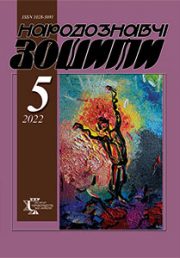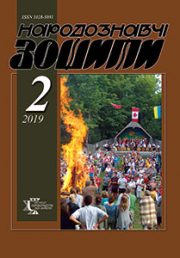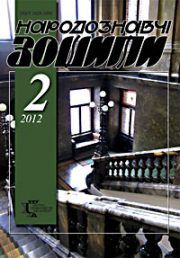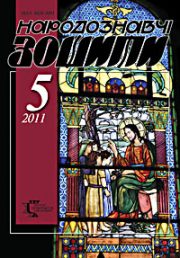The Ethnology Notebooks. 2019, № 4 (148), 861—866
УДК 793. 3:393(477)
DOI https://doi.org/10.15407/nz2019.04.861
CHOREOGRAPHIC FOLKLORE OF UKRAINE AS A MEANS REVIVAL OF THE NATIONAL CULTURE OF SOCIETY
KUTSENKO Sergiy
ORCID ID: https://orcid.org/0000-0003-0574-786X
Candidate of Pedagogical Sciences,
Associate Professor of Choreography and Artistic Culture Department
Pavlo Tychyna Uman State Pedagogical University
Contacts: e-mail: kutsenko. udpu@gmail. com
Abstract. XXI century is characterized by noticeable changes in the folklore choreographic culture of Ukraine. All of them are connected with perturbation in the life of society. However, the old traditions that are the foundation for folk dance art development should not disappear without a trace.
The article is devoted to the research of choreographic folklore in the context of the revival of the national culture of society. The author points out that the spiritual crisis in Ukraine is connected with the decline of national consciousness and the loss of traditional spiritual values, which fully reflects the urgency of the study. Choreographic folklore is both an expression of a household pattern and an aesthetic phenomenon that corresponds to the moral and spiritual principles of life. In all its genre diversity, it exists as a powerful living tradition that is objectively perceived by society as a determining factor in the stability of the cultural gene pool of Ukraine. According to the author, Ukrainian national choreography retains the rich creative heritage of the past as the most important feature in connection with nation’s life and aspirations. Choreographic folklore of Ukraine is a source of national culture.
The objective of the article is to study the choreographic folklore of Ukraine as a means of reviving the national culture of society. The methodology of the study is based on the application of historical, cultural, artistic and biographical approaches, as well as the complex use of methods of analysis, synthesis and generalization that made it possible to analyze the national choreographic heritage of Ukraine in the context of the revival of the national culture of society.
The object of the study is choreographic folklore of Ukraine. The subject of the study is the educational potential and genre variety of choreographic folklore, which preserves the deep genetic and national roots.
In conclusion, the author notes that Ukrainian folk choreographic work is rich and diverse both in terms of content and genre. It is constantly developing. The author points out the need to find and collect unforgotten materials of national choreography, the study of which will allow to contribute even more to the wealth of Ukrainian dance art and revive the national culture of society.
Keywords: choreographic folklore, national culture, Ukrainian folk dance, choreographic heritage, folklore of Ukraine.
Received 4.07.2019
REFERENCES
Borymska, H.V. (1974) Samotsvity of Ukrainian Dance. Kyiv: Mystectvo [in Ukrainian].
Vasilenko, К.Y. (1996). Ukrainian Folk-stage Dance Lexis. Kyiv: Mystectvo [in Ukrainian].
Vasilenko, К.Y. (1997). Ukrainian folk dance. Kyiv: IPK PK [in Ukrainian].
Verkhovynecj, V. (1990). Theory of Ukrainian folk dance. Kyiv: Muzychna Ukrajina [in Ukrainian].
Harasymchuk, R. (2008). Folk dances of Ukrainian Carpathians (B. 1). Lviv [in Ukrainian].
Harasymchuk, R. (2008). Folk dances of Ukrainian Carpathians (B. 2). Lviv [in Ukrainian].
Gumenyuk, А. (1963). Folk choreo graphicart of Ukraine. Kyiv: AN URSR [in Ukrainian].
Gumenyuk, А., Virsjkyj, P. (Ed.). (1969). Ukrainian Folk Dances. Kyiv: Naukova dumka [in Ukrainian].
Zajcev, J. (1976). Fundamentals of folk-stage dance. Kyiv: Mystectvo [in Ukrainian].
Kinder, K.R. (2007). Semantic of plastic symbols of Ukrainian Folk Dance Culture. Extended abstract of candidate’s thesis. Kyiv [in Ukrainian].
Kryvokhyzha, A.M. (2016). Analyzing live. Kirovograd: Centraljnoukr. Vyd-vo [in Ukrainian].
Pasternakova, M. (1964). Ukrainian woman in choreography. (2th ed.). Winnipeg; Toronto [in Ukrainian].
Chmil, V.A. (2005). Dancing of Zaporizhzhya region in the treatment of Z. Sizonenko. Melitopol: Vydavnychyi budynok MMD [in Ukrainian].
Strategy of national-patriotic upbringing of children and youth for 2016—2020 years. Retrieved from: http://zakon. rada. gov. ua/laws/show/580/2015 (Last accessed: 01.03.2019).
Bahlai, V.E. (2007). Ethnic choreography of the peoples of the world. Rostov-na Donu: Fenyks [in Russian].
Nastiukov, H.A. (1976). Folk dance on an amateur stage. Moscow: Profyzdat [in Russian].







